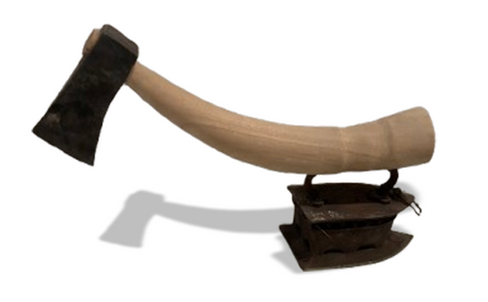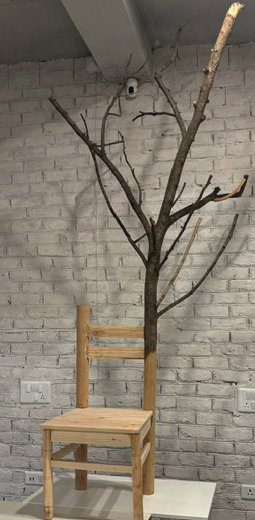A Thing of Beauty
- Ranjan Kaul

- Oct 24
- 10 min read
By Ranjan Kaul
The exhibition by architect-artist Gautam Bhatia titled “All the Beauty in the World” held at Bikaner House in October 2025 is a remarkable and amazing exploration in the ever-widening field of the visual arts. Presented by the Weft Foundation, the show featured twenty art objects created by fusing together familiar but unrelated and often conflicting manufactured items inviting viewers to make their own interpretations. The artist chose a wide array of mundane everyday objects to work with: ranging from axes, rakes, and pistols to musical instruments, tennis rackets, and pressure cookers, even toilet fixtures.
The exhibition raises moot questions about art and beauty: Can the fusing of two or more items make for an art object? What is beauty? What is the function and role of art? Can an ordinary object once divested of its original function by artistic intervention be transformed into the extraordinary? Can ascribing a title to an art object redefine its meaning? The purpose of this essay is twofold: one, of course, to critically review Bhatia’s exhibition; and two, to delve into these questions at some length.
We enter the gallery through a winding corridor with a plethora of ideation drawings with copious notes mounted on the walls of both sides of the corridor. At the end of the corridor, right below the write-up about the show, we encounter the first art object Muzzled Voice. The drawings and this art object point to what we are about to view.
Ideation drawings

Muzzled Voice, at the entrance. Photo by Ranjan Kaul
Moving aside a black curtain we see a long table in the centre of the room arrayed with the exhibits, with focus lights streaming on them. There is darkness all around except for the light falling on a couple of more exhibits placed on the sides of the room. It feels as though one has entered an operation theatre but unlike in the theatre where the patient is etherized on a table (apologies to Eliot), the objects appear animated. The atmosphere is exhilarating and intimidating at the same time. (Harsh Bhavsar of the Weft Foundation and the artist will take pains to later explain that the idea behind the display was not to intimidate but to create an intimate environment for the viewer.)

Long shot of the exhibition. Photo by Ranjan Kaul
This does not in any way detract from the “beauty” of the works. If we only go by the exhibition title, the show is purportedly about showcasing art objects of beauty. Incidentally, the exhibition title is borrowed from the title of Patrick Bringley’s memoir based on his decade-long experience of working as a guard at the Museum of Modern Art (MoMA).
Owing to the deliberate design of their creator, the fused objects in the show are assigned a singular title though they acquire new (and often multiple) meanings and identities – at times profound and subversive, at other times zany and absurd – with each work assigned a single title. According to Bhatia, the “exercise began as a minor play of the imagination, but over time developed a plot of its own.”
Left: Domestic Violence, Right: Cut Off the Supply

Non Vegetarian
Domestic Violence is represented by an axe, extending like an arm about to strike, which balances on the handle of an iron, while Cut Off the Supply shows a handpump with a pair of garden shears fitted into its nozzle – conjoined, the new object suggests the stoppage of the supply of daily utilities: water, gas, electricity. A cricket bat extends to a rifle in another work, while Waste Management is a urinal brazenly ensconced in a baby stroller. Another work Deforest has a rake emerging from the natural roots, suggestive of environmental destruction, while Elite Labour, composed of a rake and a tennis racket, contrasts two kinds of activity.
Left: Elite Labour, Right: Deforest
Left: Electric Coffee, Right: End of Music
While there is satire and irony in the works such as those described above and which bear direct reference to society, polity and ecology, there are other works that evoke different responses, including those that leave you with a wide smile owing to their idiosyncrasy: as Bhatia notes, “not for any light-hearted meaning, but for multiple mis-readings.” For example, what does one make of End of Music showing a rifle stuck onto a cello, or for that matter, Electric Coffee with the spout of the coffee pot leading to a curving electric charger? Describing the last-mentioned work in his notes, Bhatia, in a witty play of words, suggests that it could be “just a dangling metaphor of two shiny objects in an unfamiliar union.” Along with the concept drawing of the work, he adds a short piece of fiction: “It occurred to him that the coffee pot hadn’t summoned the genie but the lamp itself. Some of the magic had worn off.” Clearly, the artist is wearing two hats while sharing his fun moment with the viewer: that of the artist and the other of the writer.
Here let us pause and travel down the lanes of history to examine two key developments in the visual arts in Europe during the period following World War I. This period, marked by loss, trauma, and disillusionment, saw a revisitation of accepted norms and values, and the rupture of the cultural fabric. Philosophical movements such as Existentialism, Nihilism, and Dadaism redefined the creative landscape. Artists such as Marcel Duchamp, Tristan Tzara, and Hannah Höch, responding to the absurdity of war and bourgeois culture, rejected rationality and artistic tradition. In 1917, Duchamp presented a porcelain urinal signed “R. Mutt” (the name of the manufacturer) and titled Fountain as an art object at an exhibition. The presentation of an everyday manufactured object with just a signature and title naturally raised eyebrows since it challenged and redefined traditional notions of art in relation to skill, materiality, and aesthetics. Earlier, in 1914, he had created a “ready-made” titled Bottle Rack, which he had purchased at a department store in Paris. He went on to create more works using “ready-made” objects, such as the Bicycle Wheel mounted upside down on stool, and In Advance of the Broken Arm that showed a snow shovel inscribed with the title, portending an accident. His ideas won him both notoriety and fame and paved the way for the emergence of the genre of conceptual art in the 1960s, where the idea itself became the central creative act, based on the philosophy that the concept behind an artwork is more critical than its manifestation.
Left: Bottle Rack by Marcel Duchamp, 1914; image courtesy of Wikimedia Commons and Gallerie nazionale d’arte moderna, Rome. Right: Fountain by Marcel Duchamp, 1917; image courtesy of Wikimedia Commons and Philadelphia Museum of Art

One and Three Chairs, Joseph Kosuth, 1965; image courtesy of Wikimedia Commons
Joseph Kosuth’s One and Three Chairs (1965) is a groundbreaking conceptual artwork showing a wooden chair, a photograph of that chair in exactly the same size, and a dictionary definition of “chair.” Presenting these three images as a composite artwork, Kosuth questioned the relationship between object, image, and language, provoking viewers to reconsider what constitutes the “real” chair and how meaning is constructed through representation. Kosuth’s philosophical underpinning draws from the idea that meaning arises from language use. The work, like Duchamp’s “ready-mades”, was another major disruption in the field of art – and ‘forsuth’ there have been several proponents and practitioners of conceptual art who have extended this genre into various media.
It is against the aforementioned backdrop of modern art in the West that we examine and locate Bhatia’s sculptural art objects. At the same time, we must remember that while today there too is trauma, pain and suffering as was the case in post World War I, the socio-political climate and concerns have changed drastically. We live in an increasingly polarized world beset with conflicts and wars, geo-political uncertainties, social injustice, rising inequalities, alarming issues of gender, identity, and climate change. It is in this dysfunctional and upended environment and amid concomitant socio-cultural and philosophical concerns that Bhatia’s works assume immediacy.
Like Duchamp, Bhatia too uses manufactured “ready-mades” for creating his art objects. Duchamp signed and titled the urinal Fountain, elevating its status to an object of art and inviting viewers to imagine a “fountain” in their minds. Similarly, Bhatia fuses together two commonplace manufactured objects and gives the reinvented whole a distinct and new and, mostly, an ambiguous identity with a name. However, this is where the comparison with Duchamp ends.
A major characteristic that distinguishes Bhatia’s works from Duchamp’s “ready-mades” and the conceptual artists that followed him is Bhatia’s search for ‘completeness’ so as to claim that his creation is an art object, “a thing of beauty.” On the other hand, conceptual art does not ascribe much significance to aesthetic considerations; for conceptual artists the idea behind their creation is paramount; for them art is a philosophical inquiry, not a purely visual experience. At the heart of Bhatia’s exploration is his desire to create a certain aesthetic that is at once appealing and provocative.
“Each composition was made in such a way,” Bhatia notes, “that the pieces, however meaningless or however insightful, were still claimed by an order of aesthetics, by sculpture.” Thus, to label Bhatia as a conceptual artist would be rather restrictive and we need to coin a new name for his art – “Fusion Art” perhaps for want of a better term.
Another premise on which we explore Bhatia’s artworks is that the new and completely different identity that comes into being through the deliberate assembly of two unrelated objects does not erode their roots; they continue to retain their earlier associations and reminders of their original function. To understand this let’s take the example of building materials. Unlike materials such as brick, mortar, glass, wood, and steel which do not retain their intrinsic materiality when a building is constructed, in Bhatia’s art objects the original “building objects” do. There is thus not a complete obliteration but a metamorphosis into a new form that takes on an altogether different meaning than that of the functions of the original objects. For a moment, let us examine what this means in relation to Shiva’s cosmic dance, or tandava, symbolizing the eternal cyclical process of creation, preservation, and destruction. While Shiva dissolves the old order to clear the path for regeneration and transformation, he is also very much the preserver. The dance embodies the profound idea that destruction is not an end but a creative force, paving the way for a renewal. Here it is pertinent to reference another of Bhatia’s intriguing works, titled Birth of a Chair: a part of the chair morphing into a smooth, swollen, prenatal belly suggests the birth of a new form and identity; and as an extended metaphor, a renewal.
Elaborating on the process of making the joints and their nature in his works, Bhatia says in his that the process of joining is “less a slapping together of two disparate things, more an interlocking . . . in a careful crafting . . . Without a joint it is as if one object has morphed into another, eradicating the distinction between the same and the other . . .” The artist further adds, “It is there in the joinery that the difference lies.” While in some of the works such as in Electric Coffee and Elite Labour the joints are elegant and allow the seamless flow of one form into the other, the joining in Non Vegetarian, that has a pistol going through the body of the pressure cooker, is like a forced entry, an intrusion. This process of joining is analogous to Shiva’s dance – graceful and fierce at the same time. Thus, the nature of joining itself – softly melded or forced – so that the new creation acquires an independent distinct entity as an art object assumes considerable significance.
Left: Birth of a Chair, Right: Shoot the Messenger
Another premise on which we examine Bhatia’s works relates to semantics and language. Let us take the example of Shoot the Messenger, which depicts a pistol sitting atop a typewriter. The interpretation of the work, when viewed with the title in mind, gets greatly limited to what the idiom connotes, that is, blaming or punishing the person who delivers bad news and not addressing the issue itself. However, when seen in relation to today’s environment where journalists are being targeted for reporting on news that does not favour the establishment, we get quite another picture. Bereft of the title, the work could be interpreted altogether differently: for example, a mystery writer describing an assassin shooting his victim. Recall the earlier discussions on the works of Duchamp and Kosuth. Duchamp’s justification for the urinal being an art object stemmed from him signing it as R.Mutt and ascribing it a meaning by naming it Fountain. Similarly, Joseph Kosuth’s One and Three Chairs explored how meaning is constructed through representation, raising questions about what defines an object: its physical form, its image, or its linguistic description. In Bhatia’s case as well, the linguistic description, the title, strongly leads the viewer to its possible meaning.
What is also important here is the language used. Bhatia has chosen English with its idioms and collocations for his titles. The expression ‘shoot the messenger’ literally translated in Tamil or Hindi would not have the same meaning; so also, some of the other titles of the art objects in the show, such as Root Cause, Laboured Song, After Hours, and so on.
We now arrive at one final discussion point: Can a work created from mundane and inanimate objects that have only a specific purpose or function be transformed into a living art object that viewers find meaning in and relatedness to. This begs the question: What makes for an art object: does it need to evoke emotion, provoke thought, ignite empathy? There is no doubt in my mind that Bhatia’s “Fusion Art” meets the criteria for qualifying as an exemplary form of contemporary art.
A quick word on the exhibition display. As I’d alluded at the beginning of this essay, the darkened “Black Box” to create an atmosphere of intimacy did not work for me. The works were placed too close to each other, often encroaching into the space of another, making the whole display look crowded. Had the works been placed on separate pedestals with lights focussed on each, then perhaps the intended atmosphere would have been achieved.
A gap between intent and final outcome is not uncommon in the realm of art – often, the viewer interprets a work quite differently from what the artist wishes to convey.
In conclusion, the inventiveness of Bhatia’s compositions leads the way to the discovery of an unknown reality. The creation of art objects that lend themselves to multiple interpretations and also assigning them specific titles is quite in vein of Duchamp's paradigm that "the viewer makes the artwork." Importantly, an order of aesthetics runs through each of the art objects, however meaningless or incongruous or insightful or subversive they might be. The works claim to be part of “all the beauty in the world” (as the exhibition title suggests). In his poem Endymion Keats says that "a thing of beauty” can provide eternal joy. Beauty lies not in mere appearance – it runs deep and is multilayered, a fusion of truth, emotion, and thought. True beauty will find resonance with the observer and uncover hidden realities. Going by these definitions, each of Gautam Bhatia’s art objects does indeed qualify as a “thing of beauty”, to be admired, remembered, and treasured as a reflection of our dystopic contemporary times.

Ranjan Kaul is a visual artist, art writer and critic, curator, author, and Founding Partner of artamour. His works may viewed on www.ranjankaul.com and his insta handle @ranjan_creates.
































Comments